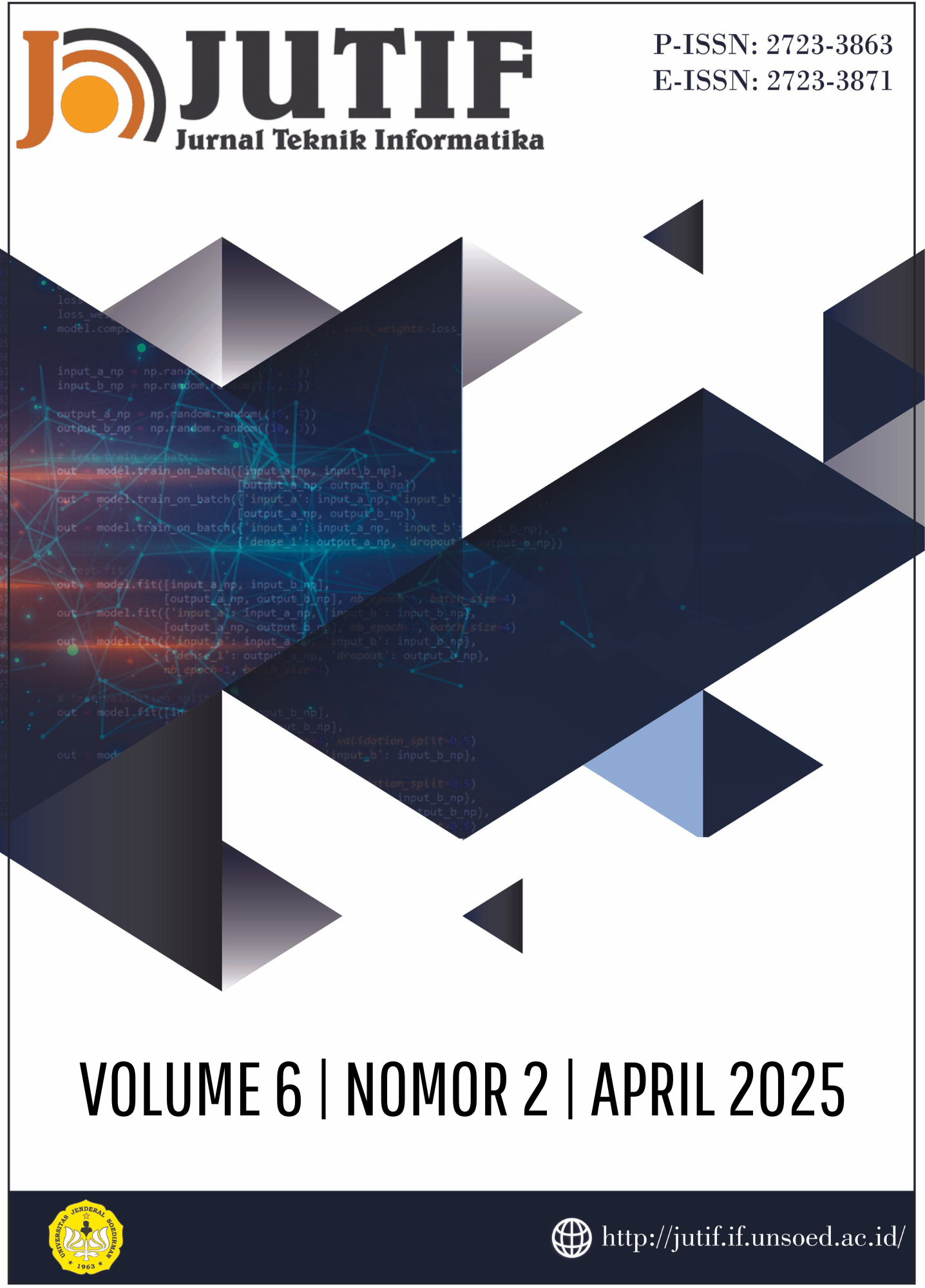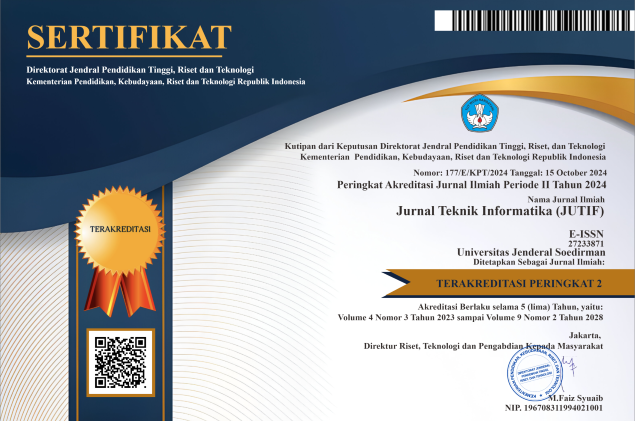Convolutional Neural Network for COVID-19 Detection Using InceptionV3 Transfer Learning
DOI:
https://doi.org/10.52436/1.jutif.2025.6.2.4094Keywords:
Convolutional Neural Network, COVID-19, Image Classification, SARS-CoV-2, Transfer LearningAbstract
The COVID-19 pandemic has underscored the need for rapid and accurate diagnostic methods. Although Reverse Transcription Polymerase Chain Reaction (RT-PCR) is the gold standard for detecting COVID-19, it presents limitations such as high costs, lengthy processing times, and the requirement for specialized personnel. Medical imaging, particularly lung X-rays, offers a viable alternative for COVID-19 detection. This study evaluates five Convolutional Neural Network (CNN) models: a handcrafted CNN, VGG-16, VGG-19, ResNet50, and InceptionV3, with the aim of enhancing classification accuracy between COVID-19 and normal lung images. The dataset, obtained from Kaggle, comprises 13,808 X-ray images, which were balanced using random oversampling to address class imbalance. Data augmentation techniques were applied to improve model generalization and mitigate overfitting. After training the models for 100 epochs, the results revealed that both VGG-19 and InceptionV3 achieved the highest accuracy, each attaining 100%, outperforming the other models. VGG-16 and CNN Handcraft also demonstrated strong performance with an accuracy of 99% and 97%, whereas ResNet50 exhibited the lowest accuracy at 78%. These findings suggest that more complex CNN architectures, such as VGG- 19 and InceptionV3, are highly effective in detecting COVID-19 from X-ray images. Future research should explore additional CNN models and employ further model tuning to optimize performance.
Downloads
References
“Mengulas Riwayat Pandemi Dunia - Update & Tren.” Accessed: Jul. 02, 2024. [Online].
Available: https://beranisehat.com/mengulas-riwayat-pandemi-dunia/
R. Filip, R. Gheorghita Puscaselu, L. Anchidin-Norocel, M. Dimian, and W. K. Savage, “Global Challenges to Public Health Care Systems during the COVID-19 Pandemic: A Review of Pandemic Measures and Problems,” Aug. 01, 2022, MDPI. doi: 10.3390/jpm12081295.
M. Chandra, K. Kumar, P. Thakur, S. Chattopadhyaya, F. Alam, and S. Kumar, “Digital technologies, healthcare and Covid-19: insights from developing and emerging nations,” Mar. 01, 2022, Springer Science and Business Media Deutschland GmbH. doi: 10.1007/s12553-022- 00650-1.
M. Ciotti, M. Ciccozzi, A. Terrinoni, W.-C. Jiang, C.-B. Wang, and S. Bernardini, “The COVID-19 pandemic,” Crit Rev Clin Lab Sci, vol. 57, no. 6, pp. 365–388, Aug. 2020, doi: 10.1080/10408363.2020.1783198.
K. D. Vihta et al., “Omicron-Associated Changes in Severe Acute Respiratory Syndrome Coronavirus 2 (SARS-CoV-2) Symptoms in the United Kingdom,” Clinical Infectious Diseases, vol. 76, no. 3, pp. E133–E141, Feb. 2023, doi: 10.1093/cid/ciac613.
F. A. AlMalki, S. Albukhaty, A. A. Alyamani, M. N. Khalaf, and S. Thomas, “The relevant information about the severe acute respiratory syndrome coronavirus 2 (SARS-CoV-2) using the five-question approach (when, where, what, why, and how) and its impact on the environment,” May 01, 2023, Springer Science and Business Media Deutschland GmbH. doi: 10.1007/s11356-022-18868-x.
J. Kesehatan Manarang, A. Suswanti Agustina, and R. Fajrunni, “Volume 6, Nomor Khusus, Oktober 2020 Perbandingan Metode RT-PCR dan Tes Rapid … 47.” [Online]. Available: http://jurnal.poltekkesmamuju.ac.id/index.php/m
C. Parellada et al., “Comparative study between an antigen test and the reverse transcription- polymerase chain reaction (RT-PCR) test for the diagnosis of COVID-19 in pediatrics,” Arch Argent Pediatr, vol. 121, no. 5, Oct. 2023, doi: 10.5546/aap.2022-02908.eng.
S. Ilahiyah and A. Nilogiri, “Implementasi Deep Learning Pada Identifikasi Jenis Tumbuhan Berdasarkan Citra Daun Menggunakan Convolutional Neural Network”.
S. M. Kasongo, “A deep learning technique for intrusion detection system using a Recurrent Neural Networks based framework,” Comput Commun, vol. 199, pp. 113–125, Feb. 2023, doi: 10.1016/j.comcom.2022.12.010.
L. Chen, S. Li, Q. Bai, J. Yang, S. Jiang, and Y. Miao, “Review of Image Classification Algorithms Based on Convolutional Neural Networks,” Remote Sens (Basel), vol. 13, no. 22, 2021, doi: 10.3390/rs13224712.
N. Awalia and A. Primajaya, “IDENTIFIKASI PENYAKIT LEAF MOLD DAUN TOMAT MENGGUNAKAN MODEL DENSENET121 BERBASIS TRANSFER LEARNING,” vol. 8,
no. 1, 2022, [Online]. Available: http://ejournal.fikom-unasman.ac.id
M. Krichen, “Convolutional Neural Networks: A Survey,” Computers, vol. 12, no. 8, Aug. 2023, doi: 10.3390/computers12080151.
G. Imam Andaru and D. Hatta Fudholi, “Pengembangan Sistem Deteksi On-Shelf Availability Produk Menggunakan Algoritma YOLOV8 pada Aplikasi Beregerak,” 2024. [Online].
Available: https://journal.stmiki.ac.id
E. N. Arrofiqoh and H. Harintaka, “IMPLEMENTASI METODE CONVOLUTIONAL NEURAL NETWORK UNTUK KLASIFIKASI TANAMAN PADA CITRA RESOLUSI TINGGI,” GEOMATIKA, vol. 24, no. 2, p. 61, Nov. 2018, doi: 10.24895/jig.2018.24-2.810.
M. F. Naufal et al., “Analisis Perbandingan Algoritma Klasifikasi Citra Chest X-ray Untuk Deteksi Covid-19,” Teknika, vol. 10, no. 2, pp. 96–103, Jun. 2021, doi: 10.34148/teknika.v10i2.331.
L. Anggraini Susanti, A. M. Soleh, B. Sartono, I. Pertanian Bogor, and P. Korespondensi, “DEEP LEARNING IMAGE CLASSIFICATION RONTGEN DADA PADA KASUS COVID-19 MENGGUNAKAN ALGORITMA CONVOLUTIONAL NEURAL NETWORK DEEP LEARNING IMAGE CLASSIFICATION CHEST X-RAY IN COVID-19 CASES USING THE CONVOLUTIONAL NEURAL NETWORK ALGORITHM”, doi: 10.25126/jtiik.2023107142.
M. Rahimzadeh and A. Attar, “A modified deep convolutional neural network for detecting COVID-19 and pneumonia from chest X-ray images based on the concatenation of Xception and ResNet50V2,” Inform Med Unlocked, vol. 19, Jan. 2020, doi: 10.1016/j.imu.2020.100360.
Jalu Nusantoro, Faldo Fajri Afrinanto, Wana Salam Labibah, Zamah Sari, and Yufis Azhar, “Detection of Covid-19 on X-Ray Image of Human Chest Using CNN and Transfer Learning,” Jurnal RESTI (Rekayasa Sistem dan Teknologi Informasi), vol. 6, no. 3, pp. 430–441, Jun. 2022, doi: 10.29207/resti.v6i3.4118.
D. Iskandar Mulyana, M. Ainur Rofik, and M. Ohan Zoharuddin Zakaria, “Klasifikasi Kendaraan pada Jalan Raya menggunakan Algoritma Convolutional Neural Network ( CNN )”.
J. A. Guzmán-Torres, L. A. Morales-Rosales, I. Algredo-Badillo, G. Tinoco-Guerrero, M. Lobato-Báez, and J. O. Melchor-Barriga, “Deep learning techniques for multi-class classification of asphalt damage based on hamburg-wheel tracking test results,” Case Studies in Construction Materials, vol. 19, Dec. 2023, doi: 10.1016/j.cscm.2023.e02378.
Faiz Nashrullah, Suryo Adhi Wibowo, and Gelar Budiman, “The Investigation of Epoch Parameters in ResNet-50 Architecture for Pornographic Classification,” Journal of Computer, Electronic, and Telecommunication, vol. 1, no. 1, Jul. 2020, doi: 10.52435/complete.v1i1.51.
U. UNGKAWA and G. AL HAKIM, “Klasifikasi Warna pada Kematangan Buah Kopi Kuning menggunakan Metode CNN Inception V3,” ELKOMIKA: Jurnal Teknik Energi Elektrik, Teknik Telekomunikasi, & Teknik Elektronika, vol. 11, no. 3, p. 731, Jul. 2023, doi: 10.26760/elkomika.v11i3.731.
R. Z. Fadillah, A. Irawan, M. Susanty, and I. Artikel, “Data Augmentasi Untuk Mengatasi Keterbatasan Data Pada Model Penerjemah Bahasa Isyarat Indonesia (BISINDO),” JURNAL INFORMATIKA, vol. 8, no. 2, 2021, [Online]. Available: http://ejournal.bsi.ac.id/ejurnal/index.php/ji
K. Alomar, H. I. Aysel, and X. Cai, “Data Augmentation in Classification and Segmentation: A Survey and New Strategies,” J Imaging, vol. 9, no. 2, Feb. 2023, doi: 10.3390/jimaging9020046.
V. Werner de Vargas, J. A. Schneider Aranda, R. dos Santos Costa, P. R. da Silva Pereira, and
J. L. Victória Barbosa, “Imbalanced data preprocessing techniques for machine learning: a systematic mapping study,” Knowl Inf Syst, vol. 65, no. 1, pp. 31–57, Jan. 2023, doi: 10.1007/s10115-022-01772-8.
T. Wongvorachan, S. He, and O. Bulut, “A Comparison of Undersampling, Oversampling, and SMOTE Methods for Dealing with Imbalanced Classification in Educational Data Mining,” Information (Switzerland), vol. 14, no. 1, Jan. 2023, doi: 10.3390/info14010054.
A. Y. Triyanto and R. Kusumaningrum, “Implementasi Teknik Sampling untuk Mengatasi Imbalanced Data pada Penentuan Status Gizi Balita dengan Menggunakan Learning Vector Quantization Implementation of Sampling Techniques for Solving Imbalanced Data Problem in Determination of Toddler Nutritional Status using Learning Vector Quantization,” vol. 19, pp. 39–50, 2017.
S. Park, Y. Hong, B. Heo, S. Yun, and J. Y. Choi, “The Majority Can Help the Minority: Context-rich Minority Oversampling for Long-tailed Classification,” 2022.
S. Diantika, “PENERAPAN TEKNIK RANDOM OVERSAMPLING UNTUK MENGATASI IMBALANCE CLASS DALAM KLASIFIKASI WEBSITE PHISHING MENGGUNAKAN ALGORITMA LIGHTGBM,” 2023.
Additional Files
Published
How to Cite
Issue
Section
License
Copyright (c) 2025 Dhimas Pratama

This work is licensed under a Creative Commons Attribution 4.0 International License.



























